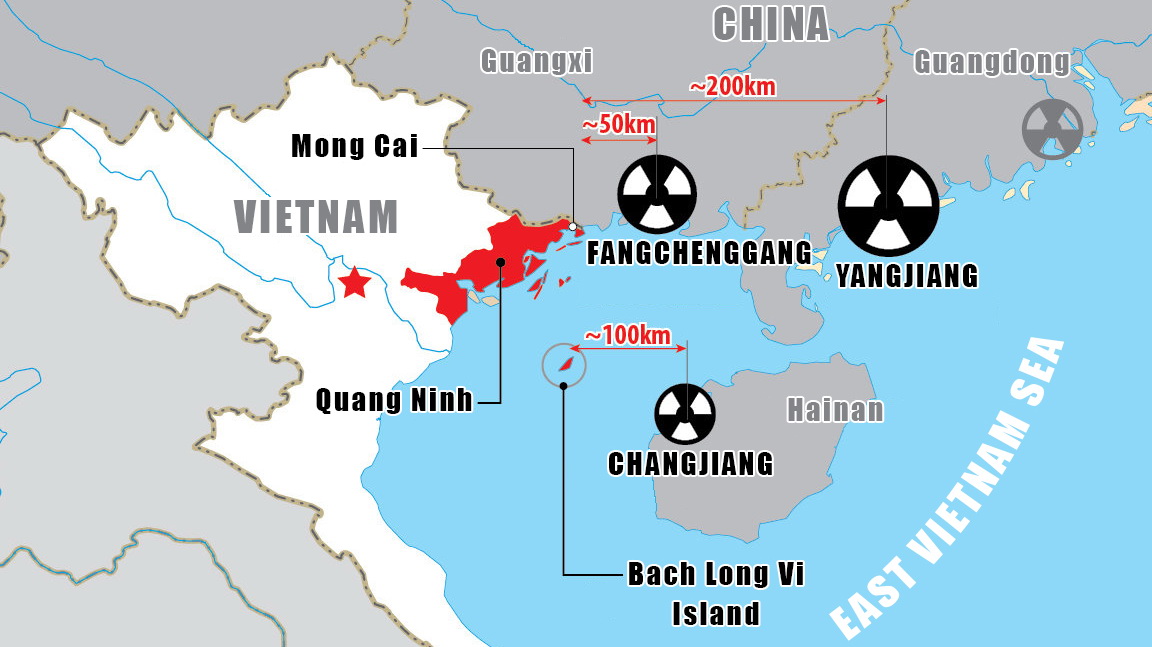As China operates the first units of three nuclear power plants located as close as 50 kilometers from Vietnamese borders, Hanoi is seeking measures to detect and respond to possible future crises related to the facilities.
China currently has three nuclear power plants built near Vietnamese territory, Fangchenggang Nuclear Power Plant in Guangxi, Changjiang Nuclear Power Plant in Hainan Province, and Yangjiang Nuclear Power Plant in Guangdong Province.
Fangchenggang is located only 50 kilometers from the northern Vietnamese province of Quang Ninh, while Changjiang lies 100 kilometers off Vietnam’s Bach Long Vi Island in the Gulf of Tokin.
The farthest among the three, Yangjiang, is 200 kilometers from Vietnamese borders.
As of 2016, portions of these plants have already begun commercial operations with a total generation capacity of 5,100 MW. Upon completion, these three nuclear power plants alone will have a total of 18 reactors.
According to general safety requirements published by the International Atomic Energy Agency (IAEA), the area surrounding a nuclear reactor with a capacity from 1,000MW must be prepared for a nuclear radiological emergency.
Some of Vietnam’s northern provinces, including Quang Ninh, are located within the extended planning distance (EPD) (30-100 kilometers from a reactor) and ingestion and commodities planning distance (ICPD) (100-300 kilometers from a reactor) as defined by the IAEA.
This means arrangements shall be made in these provinces to conduct monitoring and assessment of the radiological situation off the site and to take response action to protect the food chain and water supply, according to IAEA guidelines.
According to Dr. Nguyen Hao Quang, vice president of the Vietnam Atomic Energy Institute (VINATOM), a plan to establish a radiation monitoring network was widely discussed in Vietnam a few years back.
The plan includes a control center and four regional centers run by the Ministry of Science and Technology, 16 monitoring stations run by local administrations, and one military radioactivity reconnaissance system run by the Ministry of National Defense.
However, Quang said, the total investment capital for the plan would amount to VND1 trillion (US$44.64 million), which has been holding the plan back from being carried out.
The vice president added that VINATOM would begin work on the monitoring network as early as 2017, the construction of which would be divided into two phases, 2017-2020 and 2021-2025.
“Radiation is invisible and knows no border. Even if Vietnam doesn’t have any nuclear power plants of its own, we still need to establish a national network of radiation monitoring and warning, considering the fact that we are neighbors of countries that already have or is planning to have nuclear plants such as China, Thailand, Indonesia, and Cambodia,” Son explained.
Calculations by Vietnamese nuclear experts based on climate cycles showed that the Vietnamese localities most vulnerable to a radiological emergency from the Chinese nuclear plants are Quang Ninh, Lang Son, Lao Cai, Hai Phong, Nam Dinh, Nghe An, and Hanoi.
These provinces and cities would be prioritized when it comes to the construction of monitoring stations, Quang said.
Vietnam has been a signatory to the IAEA’s Convention on Early Notification of a Nuclear Accident since 1987, and therefore would receive early notifications in case of a nuclear emergency, according to Vuong Huu Tan, director of the Vietnam Agency for Radiation and Nuclear Safety (VARANS).
In addition, the Vietnamese Ministry of Science and Technology has joined bilateral talks with its Chinese counterpart to discuss the issue of nuclear safety, Tan said.
An agreement on exchanging nuclear information will soon be inked between VARANS and China’s National Nuclear Safety Administration (NNSA), according to the Vietnamese director.

Dr. Nguyen Hao Quang, vice president of the Vietnam Atomic Energy Institute. Photo: Tuoi Tre
Like us on Facebook or follow us on Twitter to get the latest news about Vietnam!























































